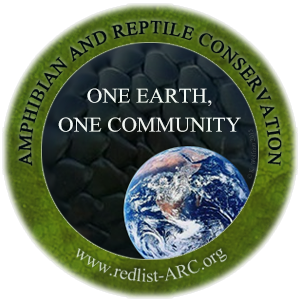|
VOLUME 5 (3) CONSERVATION
BREEDING
PROGRAMS
INTERNATIONAL CHAPTER - AMPHIBIAN
AND REPTILE CONSERVATION
NOTIFICATION: This website and its affiliates are the official Internet
website portals for the Amphibian and Reptile Conservation journal and our global
conservation network. We own all copyright, exclusive of authors copyright, produced by
any proxy fraudulently presenting as Amphibian and Reptile Conservation including the
fraudulent www.amphibian-reptile-conservation.org as published by the "Amphibian and Reptile Conservation organisation" as
an illicit group led by Craig Hassipakis. Craig Hassipakis has a long and dismal history of
fraudulent activities, including recently committing perjury in an attack on our global
conservation network, as we document see Internet Fraud.
For notification
of the publication of our future articles on Conservation Breeding Programs
please join our members
list at MEMBERSHIP
Table of
Contents
|
Zoo based
amphibian research and Conservation Breeding Programs (CBPs). Robert K Browne, Katja
Wolfram, Gerardo Garcia, Mikhail F Bagaturov, Zjef JJM Pereboom.
Amphibian and Reptile
Conservation 5(3):1-14.
Low resolution PDF 893K
High res. PDF
3479K
|
 |
|
Summary: We explore “Zoo-based amphibian research and conservation
breeding programs” through a literature review and a survey of research publication
with public and subscription search engines. Amphibians are ideal candidates for
zoo-based amphibian research and CBPs because of their generally small size, high
fecundity, ease of husbandry, and amenability to the use of reproduction
technologies. Zoo-based amphibian research and CBPs can include both in situ
and ex situ components that offer excellent opportunities for publicity and
education".
|
Summary: We
report the successful keeping and breeding of Megophrys nasuta at the Cologne Zoo’s
Amphibian Breeding Unit. We also document the development and morphology of different larval stages
of M. nasuta. Ovipositions were not seasonal and took place after a drier phase in the
terrarium followed by simulation of rain. The larvae hatched about one week after egg
deposition. Total time to metamorphosis was 2.5-3.5 months. Larvae developed faster at higher
temperatures and lower densities.
Summary:
Captive management and reproduction of the Harlequin toad from Suriname (Atelopus
flavescens) at Cologne Zoo. Egg deposition was stimulated by maintaining A.
flavescens in a drier environment followed by a wet period. We provide for the first time an
overview of the larval development from oviposition to metamorphosis, including diagnostic
morphological characters. Larvae hatched about five days after egg deposition. Tadpoles are
gastromyzophorous and were observed rasping algae. The average time for larval development to stage
41 was 100-130 days, with faster development at higher temperatures. We were able to recognize
individuals due to a constant color pattern.
Summary: The Bornean frogs of the genus Staurois live exclusively
along fast-flowing, clear water rainforest streams, and are famous for displaying a variety of
visual signals, including foot flagging. Their extraordinary behavior, and the continued loss of
their natural habitat due to deforestation and subsequent pollution, make them a group of target
species for captive breeding, as well as behavioral research. The Vienna Zoo has pioneered in the
development of a research and conservation project for S. parvus and S. guttatus.
We implemented two breeding and research arenas, offering an artificial waterfall and different
options for egg deposition in a bio-secure container facility. Two months after introducing the
frogs, we observed amplectant pairs and the first tadpoles. Vienna Zoo is the first zoo worldwide
that has succeeded in breeding foot-flagging frog species and meanwhile has recorded over 900
tadpoles and at least 470 juveniles. One of the most striking observations has been the use of
foot-flagging signals in recently metamorphosed S. parvus. This corroborates our
assumption that “foot flagging” is employed as intraspecific spacing mechanism. The breeding
success of two Staurois species at the Vienna Zoo can help in species conservation as it increases
our knowledge on conditions necessary to breed tropical stream-dwelling anuran species found to be
particularly threatened in nature. Furthermore,the captive colony provides research conditions to
better understand the role of “foot flagging” as a visual signal component in anuran
communication.
Summary:
Madagascar is ranked 12th in amphibian species richness by the International Union on the
Conservation of Nature (IUCN) and is considered to be one of the highest priority countries for
amphibian conservation. In response to the tremendous threats facing Madagascar’s amphibians, a
national strategy for amphibian conservation was developed, emphasizing the need for ex situ
conservation action. This project was officially launched through a collaborative effort between a
community-run organization, the IUCN, and the Malagasy government. We discuss the process for
developing and implementing this project which has included facility construction, terrarium
building, culturing local feeder insects, and the training of Malagasy technicians. This is the
first captive breeding and amphibian conservation project in Madagascar may become a center for
training and education in an area of Madagascar that contains tremendous amphibian diversity and
endemism.
|
Captive management and
breeding of the Critically Endangered Southern Corroboree Frog
(Pseudophryne
corroboree)(Moore 1953) at Taronga and
Melbourne Zoos. Michael McFadden, Raelene Hobbs, Gerry Marantelli, Peter Harlow,
Chris Banks and David Hunter. 2013. Amphibian and Reptile
Conservation 5(3):70-87.
Low resolution PDF 600K
High res. PDF 3600K
|
 |
|
 |
Summary: The Southern Corroboree Frog Pseudophryne
corroboree is a small myobatrachid
frog from south-eastern Australia that has rapidly declined largely due to disease from the
amphibian chytrid fungus Batrachochytrium dendrobatidis. As a key recovery effort to
prevent the imminent extinction of this species, an ex situ captive breeding program has
been established. Successful captive breeding protocols have been established and key factors
in achieving breeding include providing an adequate pre-breeding cooling period for adult frogs,
separation of sexes during the non-breeding period, allowing female mate-choice via the provision
of numerous males per enclosure and permitting the females to attain significant mass prior to
breeding. To date, the success of captive breeding from 2010–2012 has permitted the reintroduction
of 1,060 captive-produced eggs and an increasing captive population size that will support
conservation research and provide insurance against further declines.
|
















